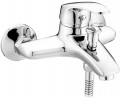Jet depth
Distance from the fixing point (for vertically mounted taps) or from the centre of the mounting hole (for horizontally mounted taps) to the middle of the spout. It is a characteristic that determines the "reach zone" of the tap.
Diverter
A diverter is a device that switches a water flow between spout and shower head. The design of such a device and the way it is controlled can be different, in modern taps you can mainly find the following options:
— Button. Diverters of this type have the form of a button; but its design depends on the characteristics of a particular tap. In relatively simple mechanical models (most of them), the button is also made mechanical, and to switch from spout to shower, you need to pull it up. And switching in the opposite direction — from a shower to a spout — can often be carried out not only manually, but also automatically, when the water is turned off (see "Features — Shower / bath auto switch"). In some taps, auto-switching can also be blocked by the user (usually by turning the button in the up position).
In turn, in advanced electronic devices, such a diverter is made in the form of an electric button that closes the contacts that control the valve.
— Lever. Diverter in the form of a rotary lever. Most often, this lever directly controls the valve that switches the flow of water. This design is considered somewhat less reliable than push-button, but it is much simpler and cheaper, which makes it very popular — especially in relatively inexpensive taps. But in premium devices, this type of diverter can operate according to other, more advanced principles — for example, a lever can work as an electronic switch.
— Turning the spout. A r...ather rare and specific option: the role of the lever that controls the flow of water is performed directly by the spout, to the base of which a shower hose is connected. Such a control, usually, works as follows: while the spout is perpendicular to the tap body, water flows through it, and to switch to the shower, the spout turns, being under the tap. Such devices look interesting, and are convenient to use. On the other hand, they are quite complex and expensive, and the spout itself, for a number of reasons, is typically made quite short. Therefore, this variant has not gained popularity.
— Removable. A diverter located outside the body — usually between the tap itself and the spout. Typically, on one side of such a device there is a control element (most often a small lever or a rotary tap), and on the other, a pipe for connecting a shower hose. And the name "removable" suggests that this part can be easily removed if needed — unlike, for example, push-button or lever solutions, which are usually built directly into the tap body and are very difficult to dismantle or replace. Accordingly, after removal, the diverter can either be replaced with another one, or removed altogether by connecting the spout directly to the tap. This is the main advantage of this option: in case of malfunctions in the diverter, it can be removed without any problems for repair or replacement, while the tap (with the exception of the “shower part”) remains fully operational.
Country of brand origin
Country of origin of the brand under which the tap is marketed. Usually, it is indicated by the "homeland" of the manufacturing company or by the location of its headquarters. The brands under which modern mixers are produced come mainly from the following countries (in alphabetical order):
Austria,
Belgium,
Germany,
India,
Spain,
Italy,
China,
Poland,
Russia,
Turkey,
Czech Republic,
Finland,
France,
Sweden.
There are many stereotypes associated with the “nationality” of brands and products, but most of them have no basis nowadays. First, the actual place of production is often different from the brand's country of origin. Secondly, the quality of the goods depends not so much on geography, but on the policy of a particular company and how carefully this very quality is controlled in it. Therefore, you should pay attention to the country of origin of the brand only if you fundamentally want or (do not want) to support a manufacturer from a certain state. Quality is best judged by the reputation of a particular
...brand and the overall price category of the tap.
